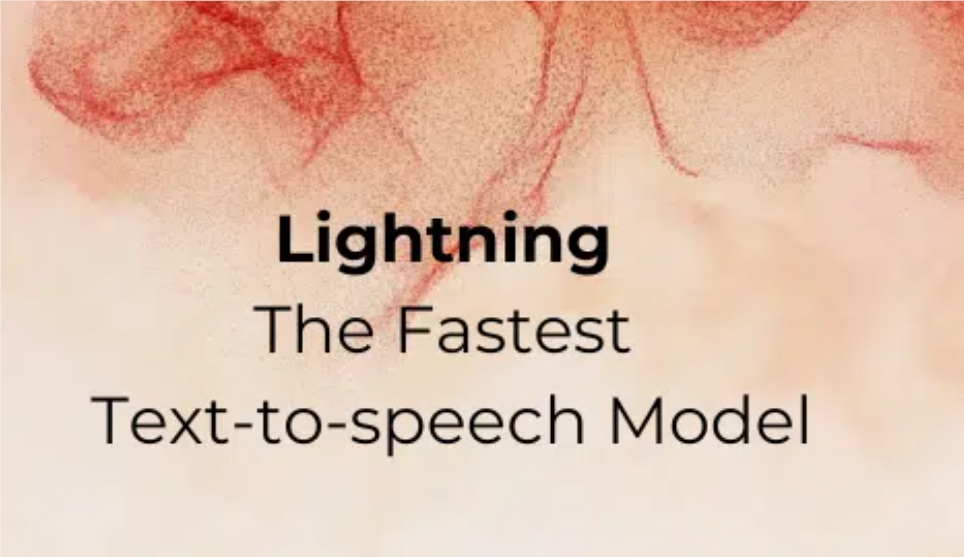Smallest.ai, an American AI startup, has released its latest product, Lightning, a text-to-speech (TTS) model with amazing speed. Lightning generates up to 10 seconds of audio in 100 milliseconds, supports multiple accents in English and Hindi, and plans to support more languages. Its low cost (only $0.02 per minute) and simple REST API design make it ideal for voice robot developers, greatly reducing development and operation costs, and improving voice synthesis efficiency and access to applications. sex. This article will analyze the various functional characteristics, market positioning and smallest.ai's corporate vision in detail.
Recently, smallest.ai, an AI startup based in San Francisco, California, launched its new product Lightning, a text-to-speech (TTS) model that can generate up to 10 seconds of audio in 100 milliseconds. The advancement of this technology has enabled developers around the world to build highly simulated voice robot applications, with extremely short delay times, reducing implementation costs and improving application accessibility.

Lightning currently supports multiple accents in English and Hindi, and the team also plans to quickly add more languages to meet market demand. Pricing at just US$0.02 per minute (about INR 1.6) this model provides a cost-effective solution for voice robot developers, with the application running costs controlled below 1 per minute, significantly Reduce the cost of building voice robots and expand the market accessibility.
Unlike the traditional TTS model that relies on streaming and network sockets to increase server burden and complex scalability, Lightning uses a simple REST API design to enable audio to be delivered in about 100 milliseconds, avoiding the continual streaming. Server pressure. This fast processing power and cost efficiency make it a significant alternative in the voice robotics industry.
Lightning's product features can be summarized as follows
1. Speed and efficiency. Known as the world's fastest text-to-speech, the Lightning model generates 10 seconds of surreal audio in 100 milliseconds, real-time voice synthesis, meeting the needs of fast response.
2. Small and compatibility. With a video memory requirement of less than 1GB, the model is small in size and can easily run on most consumers and edge devices, reducing hardware requirements.
3. Multilingual support. Multilingual and accent support, currently supports multiple accents in English and Hindi, and plans to quickly add more languages to meet the needs of users around the world.
4. Highly customizable. Style diffuser, using a special style diffuser, adjusts the audio style according to user needs, making the generated voice more natural and emotional.
5. Simple integration. REST API integration provides a simple REST API interface, where developers can quickly integrate lightning models into existing systems, eliminating complex WebSocket connections.
6. The affordable pricing starts at US$0.04 per minute, which is suitable for all types of enterprises. It provides customized pricing solutions for enterprises with large usage.
smallest.ai was founded by Indian Institute of Technology Guwahati alumni Sudarshan Kamath and Akshat Mandloi. Kamath said smallest.ai’s low-price strategy is due to their focus on data quality and model efficiency. “Our model is much smaller than competitors like ElevenLabs, but we achieve high-quality voice output with highly refined data,” he explains.
Voice robot developers who had early access to Lightning reported that their operating costs were reduced by 8 times, while audio quality was improved. In addition to real-time voice robot apps, Lightning can also be used to create voiceovers for audiobooks and social media content, such as platforms like Instagram and YouTube. Non-developers can also access Lightning through the Waves Speech platform to experience features including sound cloning and accent conversion, which are currently in beta.
Kamath said in an exclusive interaction with the Journal of Analytics India: “When we started building it, we realized that the models required for existing voice robots are not mature enough for Indian languages. Existing models in non-English languages simply cannot achieve production.” Require."
In June this year, smallest.ai also launched the AWAAZ model, which supports sound cloning through short audio clips, and is priced at a competitive price. The model is designed to meet scalable applications in the regional language market and to provide enterprise-level security and compliance. Asked about its mission, Kamath said: “Why are a billion people not communicating with AI voice every day, despite the huge advances in voice AI technology? This is a problem we are working hard to solve.”
Project entrance: https://smallest.ai/blog/lightning-fast-text-to-speech
Key points:
Lightning Text-to-Speech model generates audio in 100 milliseconds, supports multiple accents in English and Hindi, and will expand more languages in the future.
With a low cost of only $0.02 per minute, it significantly reduces the operating costs of voice robot developers.
Lightning is not only suitable for voice robots, but also for audiobooks and social media dubbing, making it easy for developers and non-developers to use.
In short, smallest.ai's Lightning model is expected to revolutionize the field of speech synthesis with its speed, efficiency, low cost and ease of use, providing global developers and users with more convenient and economical voice AI services. Its vision to solve the inclusiveness of voice AI technology is also worthy of attention.